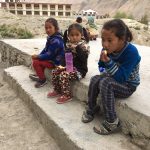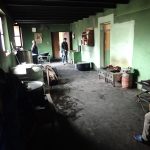A year ago I’d never heard of the Spiti Valley in northern India. For the similarly uninitiated, it is wedged between two major tourist regions: the Garhwal Himalaya to the south and the Ladakh ranges to the north. Despite being so close to these areas however, Spiti is a really difficult place to get to. There is no airport and only one unsealed road in and out. Snow closes the road from November to May and it is challenging and at times impassable the rest of the year. The trip from Keylong to Kaza, the main town in the Spiti valley, is only 160 km, but it took us a full 12 hours on the worst road I have ever been on. Not surprising then that Spiti has remained remote and isolated from the modern world for so long.

We knew of the Munsel-Ling school from a friend who sponsors a student there. Battling extremely limited internet connectivity in Kaza, I found the school’s page on Facebook and was able to get a message out about a possible visit. Lama Tashi replied right away and let us know we were welcome the next day.
We arrived at Munsel-Ling school not knowing quite what to expect. There is a small building for “Admin”, and there we found Lama Tashi and his team waiting for us, extremely welcoming and brimming with enthusiasm. His English is excellent and he has a modest, humble presence that belies his stature in the Buddhist community. It was immediately clear that we were going to be treated as honoured guests, with tea and refreshments, a full lunch and student performances. It was amazing.
We started with a tour of the main campus, which is much larger than I expected. The classrooms are small, with about 25 students per class. Teachers are local Spitians as well as some Indians from outside. Everyone speaks English and the quality of education is evident. In fact several graduates from Munsel-Ling have gone on to university in India and, significantly, some have returned to Spiti as doctors and other professionals to serve their community. It is inspirational and it highlights the impact of this remarkable school on Spiti.
Most students at Munsel-Ling live at the school for much of the year, and we visited a number of their boarding houses and rooms. Accomodation is basic, dorm style, with outside toilets. Each student has a small trunk or suitcase for their clothes and personal possessions, all stacked in a storage area outside each dorm. Winter heat is provided by wood stoves, and we saw lots of wood around the campus being prepared and stored for the coming cold.
The kitchens and dining rooms were also interesting. Feeding so many students is a major undertaking and there are huge pots for cooking, a massive rice cooker, and lots of food and fresh fruit. All cooking is done on propane and kerosene, but there is a wood-fire backup system as well. The diet appears to be as nutritious as possible.
There is a special area on campus for the very young children (4 -6 years old) with play areas, small classrooms, full-time staff and separate dining rooms. The teachers we saw were incredibly hands-on and caring, doing everything they could to help the little ones get through the day without parents. It was both heartening and heartbreaking to witness the lengths to which some families will go to ensure the best possible futures for their children.
The library and computer rooms are a central part of the school. The library / learning centre in particular is lovely, with many books, local art, and comfortable chairs. It relies on donations and we were told that new books, especially classroom sets, are always welcome.
We visited the medical center next where concrete efforts to improve student health, student nutrition, and dental hygiene were evident. This is facilitated in part through an ongoing collaboration with the University of British Columbia Global Health Initiative. They keep detailed student health records, and an analysis of the school’s meal program was underway to determine if any changes needed to be made. We were impressed.
There is much evidence of foreign aid at Munsel-Ling. The new TRAS-funded laundry facility, although basic, is clean and efficient and great for students to learn self-sufficiency. Likewise, a new dual-season toilet block is almost completed, with flush toilets for the summer and pit toilets for the winter. Huge new cisterns are part of this project as well, benefiting the whole campus. There is also a large diesel generator for dealing with power outages, water filtration systems, and a computer network. Lama Tashi is full of plans and ambitions for future projects as well as being committed to completing the ones that are in progress. New schools, hostels and other programs are already underway in other parts of Spiti.
We left Munsel-Ling with great enthusiasm for Lama Tashi and his organisation and amazement at his ability to leverage the resources and goodwill around him. He has had a profound impact on Spiti and we can only assume there is much to come.

















